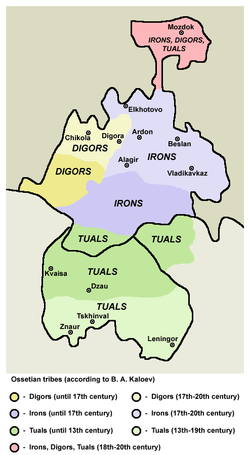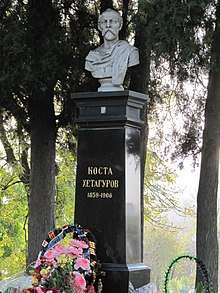Ossetians
The Ossetians or Ossetes (/ɒˈsɛtiənz/; Ossetian: ир, ирæттæ,ирон, ir, irette,iron; дигорӕ, дигорӕнттӕ, дигорон, digore, digorentte, digoron) are an Iranic ethnic group of the Caucasus Mountains, indigenous to the ethnolinguistic region known as Ossetia[23][24][25]. They speak Ossetic, an Eastern Iranian (Alanic) language of the Indo-European language family, with most also fluent in Russian as a second language. Although Ossetian is related to the Indo-European languages owing to its origin, it is not mutually intelligible with any other language of the family today.[26] Ossetic, a remnant of the Scytho-Sarmatian dialect group which was once spoken across the Pontic–Caspian Steppe, is one of the few Iranian languages inside Europe.[27]
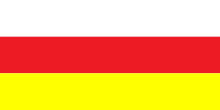 | |
| Total population | |
|---|---|
| ± 600,000 | |
| Regions with significant populations | |
| 558,515[1] | |
| (in | 480,310[2] |
| 51,000[3][4] | |
(excluding South Ossetia) | 14,385[5] |
| 50,000[6][7][8] | |
| 7,861[9] | |
| 5,823[10] | |
| 4,830[11] | |
| 4,308[12] | |
| 2,066[13] | |
| 1,170[14] | |
| 758[15] | |
| 700[16] | |
| 554[17] | |
| 403[18] | |
| 331[19] | |
| 285[20] | |
| 119[21] | |
| 116[22] | |
| Languages | |
| Ossetian, Russian, Georgian | |
| Religion | |
| Predominantly † Eastern Orthodox Christianity with a sizeable minority professing Uatsdin, and Islam | |
| Related ethnic groups | |
| Pre-Alanic native Caucasian people, Scythians, Sarmatians, Alans, the Jassic people of Hungary, neighbouring Caucasian peoples. | |
a. ^ The total figure is merely an estimation; sum of all the referenced populations. | |
The Ossetians mostly populate Ossetia, which is politically divided between North Ossetia–Alania in Russia, and South Ossetia, a de facto independent state with partial recognition, closely integrated in Russia and claimed by Georgia. Their closest relatives, the Jász, live in the Jászság region within the north-western part of the Jász-Nagykun-Szolnok County in Hungary.
Ossetians are mostly Eastern Orthodox Christian, with sizable minorities professing Uatsdin or Islam.
Etymology
The Ossetians and Ossetia received their name from the Russians, who adopted the Georgian designations Osi (ოსი) (sing., pl.: Osebi (ოსები)) and Oseti ("the land of Osi" (ოსეთი)), used since the Middle Ages for the single Iranian-speaking population of the Central Caucasus and probably based on the old Alan self-designation "As". As the Ossetians lacked any single inclusive name for themselves in their native language, these terms were accepted by the Ossetians themselves already before their integration into the Russian Empire.[28]
This practice was put into question by the new Ossetian nationalism in the early 1990s, when the dispute between the Ossetian subgroups of Digoron and Iron over the status of the Digoron dialect made the Ossetian intellectuals search for a new inclusive ethnic name. This, combined with the effects of the Georgian-Ossetian conflict, led to the popularization of "Alania", the name of the medieval Sarmatian confederation, to which the Ossetians traced their origin, and inclusion of this name into the official republican title of North Ossetia in 1994.[28]
Subgroups
- Iron in the east and south form a larger group of Ossetians. They speak Iron dialect. Irons are divided into several subgroups: Alagirs, Kurtats, Tagaurs, Kudar, Tual, Urstual, and Chsan.
- Digoron in the west. Digors live in Digora district, Iraf district, and some settlements in Kabardino-Balkaria and Mozdok district. They speak Digor dialect.
Culture
| Part of a series on the |
| Culture of South Ossetia |
|---|
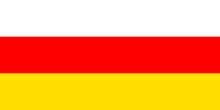 |
| History |
| People |
| Languages |
|
Mythology and folklore |
| Cuisine |
| Religion |
| Literature |
|
Music and performing arts
|
|
Symbols
|
Mythology
The folk beliefs of the Ossetian people are rooted in their Sarmatian origin and Christian religion, with the pagan gods having been converted into Christian saints. The Nart saga serves as the basic pagan mythology of the region.[31]
Music
History
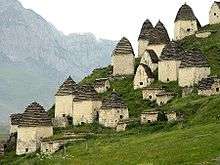
Pre-history (Early Alans)
The Ossetians descend from the Alans,[32] a Sarmatian tribe (Scythian subgroup of the Iranian ethnolinguistic group).[33] The Alans were the only branch of the Sarmatians to keep their culture in the face of a Gothic invasion (c. 200 CE), and those who remained built a great kingdom between the Don and Volga Rivers, according to Coon, The Races of Europe. Between 350 and 374 CE, the Huns destroyed the Alan kingdom, and the Alan people were split in half. One half fled to the west, where they participated in the Barbarian Invasions of Rome, established short-lived kingdoms in Spain and North Africa, and settled in many other places such as Orléans, France. The other half fled to the south and settled on the plains of the North Caucasus, where they established their medieval kingdom of Alania.
Middle Ages
In the 8th century a consolidated Alan kingdom, referred to in sources of the period as Alania, emerged in the northern Caucasus Mountains, roughly in the location of the latter-day Circassia and the modern North Ossetia–Alania. At its height, Alania was a centralized monarchy with a strong military force and had a strong economy that benefited from the Silk Road.
After the Mongol invasions of the 1200s, the Alans were forced out of their medieval homeland south of the River Don in present-day Russia. Due to this, the Alans migrated toward the Caucasus Mountains, where they would form three ethnographical groups; the Iron, the Digoron, and the Kudar. The Jassic people were a fourth group that migrated in the 13th century to Hungary.
Modern history
In more-recent history, the Ossetians participated in the Ossetian–Ingush conflict (1991–1992) and Georgian–Ossetian conflicts (1918–1920, early 1990s) and in the 2008 South Ossetia war between Georgia and Russia.
Key events:
- 1774 — Ossetia becomes part of the Russian Empire.[34]
- 1801 — Following the Treaty of Georgievsk, the modern-day territory of South Ossetia becomes part of the Russian Empire, along with Georgia.[35]
- 1922 — Soviet Union Created South Ossetian Autonomous Oblast as part of the Georgian SSR and North Ossetian Autonomous Soviet Socialist Republic as part of the Russian SFSR.
- 20 September 1990 – The independent Republic of South Ossetia is formed. Though it remained unrecognized, it detached itself from Georgia de facto. In the last years of the Soviet Union, ethnic tensions between Ossetians and Georgians in Georgia's former Autonomous Oblast of South Ossetia (abolished in 1990) and between Ossetians and Ingush in North Ossetia evolved into violent clashes that left several hundred dead and wounded and created a large tide of refugees on both sides of the border.[36][37]
Language
The Ossetian language belongs to the Eastern Iranian (Alanic) branch of the Indo-European language family.[32]
Ossetian is divided into two main dialect groups: Ironian[32] (os. – Ирон) in North and South Ossetia; and Digorian[32] (os. – Дыгурон) in western North Ossetia. In these two groups are some subdialects, such as Tualian, Alagirian, and Ksanian. The Ironian dialect is the most widely spoken.
Ossetian is among the remnants of the Scytho-Sarmatian dialect group, which was once spoken across the Pontic–Caspian Steppe. The Ossetian language is not mutually intelligible with any other Iranian language.[26]
Religion
Prior to the 10th century, Ossetians were strictly pagan. They were partially Christianized by Byzantine missionaries in the beginning of the 10th century.[40] By the 13th, most Ossetians were Eastern Orthodox Christians[32] as a result of Georgian influence and missionary work.[41][42]
Islam was introduced during the 16th and 17th century by the converted members of the Circassian Kabarday tribe[43] (who had been introduced to that religion by Tatars during the 15th century), who had taken over territory in Western Ossetia occupied by the Digor. However, Islam did not successfully spread to rest of the Ossetian people.[44]
In 1774 Ossetia became part of the Russian Empire, which strengthened Orthodox Christianity considerably by sending Russian Orthodox missionaries there. However, most of the missionaries chosen were churchmen from Eastern Orthodox communities living in Georgia, including Armenians and Greeks, as well as ethnic Georgians. Russian missionaries were not sent, as this would have been regarded by the Ossetians as too intrusive.
Today, the majority of Ossetians from both North and South Ossetia follow Eastern Orthodoxy.[32] Assianism (Uatsdin or Assdin in Ossetian), the Ossetian ethnic religion, is also widespread among Ossetians, with ritual traditions like animal sacrifices, holy shrines, non-Christian saints, etc. There are temples, known as kuvandon, in most villages.[45] According to the research service Sreda, North Ossetia is the primary center of Ossetian Paganism, and 29% of the population reported practicing pagan faiths in the 2012 Russian census.[46] Assianism has been rising in popularity since the 1980s.[47]
Economy
The northern Ossetians export lumber and cultivate various crops, mainly corn. The southern Ossetians are chiefly pastoral, herding sheep, goats, and cattle. Traditional manufactured products include leather goods, fur caps, daggers, and metalware.[32]
Demographics
Outside of South Ossetia, there are also a significant number of Ossetians living in Trialeti, in north-central Georgia. A large Ossetian diaspora lives in Turkey, and Ossetians have also settled in Belgium, France, Sweden, Syria, the United States (primarily New York City, Florida and California), Canada (Toronto), Australia (Sydney), and other countries all around the world.
Russian Census of 2002
The vast majority of Ossetians live in Russia (according to the Russian Census (2002)):

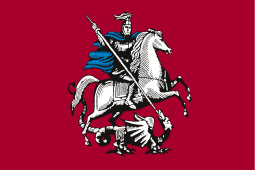
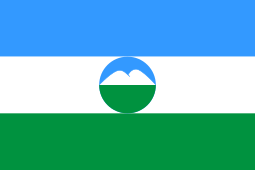
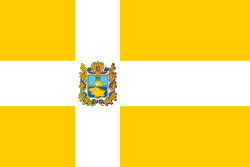
.png)
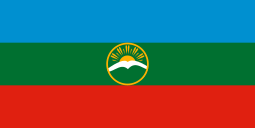



Genetics
The Ossetians are a unique ethnic group of the Caucasus, speaking an Indo-European language surrounded mostly by Caucasian ethnolinguistic groups, the other non-Caucasian tribes include the Karachays and Balkars. The Y-haplogroup data indicate that North Ossetians are more similar to other North Caucasian groups, and South Ossetians to other South Caucasian groups, than the two are to each other. With respect to mtDNA, Ossetians are significantly more similar to some Iranian groups than to Caucasian groups. It is thus suggested that there is a common origin of Ossetians from the Proto-Iranian Urheimat, followed by subsequent male-mediated migrations from their Caucasian neighbours.[48]
Gallery
 Ossetian woman in traditional clothes, early years of the 20th century
Ossetian woman in traditional clothes, early years of the 20th century Ossetian women working (19th century)
Ossetian women working (19th century) Ossetian Northern Caucasia dress of the 18th century, Ramonov Vano (19th century)
Ossetian Northern Caucasia dress of the 18th century, Ramonov Vano (19th century) Three Ossetian teachers (19th century)
Three Ossetian teachers (19th century) Ossetian girl in 1883
Ossetian girl in 1883 Sergei Guriev, economist
Sergei Guriev, economist Nikolay Bagrayev, politician
Nikolay Bagrayev, politician- South Ossetian performers
._F._17._Oss%C3%A8the_(Oss%C3%A8te)%2C_Koban._Mission_scientifique_de_Mr_Ernest_Chantre._1881.jpg) Ossetian man in 1881
Ossetian man in 1881 Soslan Ramonov, amateur wrestler
Soslan Ramonov, amateur wrestler- Ruslan Karaev, professional kickboxer
- Vladimir Gabulov, Ossetian goalkeeper
 Valery Gergiev, conductor
Valery Gergiev, conductor
See also
- Alans
- Digor (people)
- Iazyges
- Iron (people)
- Jassic people
- Alexander Kubalov
- Ossetians in Trialeti
- Ossetians in Turkey
- Peoples of the Caucasus
- Sarmatians
- Scythians
- Terek Cossacks
References
- "Russian Census 2010: Population by ethnicity" (XLS). Perepis-2010.ru (in Russian). Retrieved 2017-08-21.
- "Всероссийская перепись населения 2002 года". Perepis2002.ru. Retrieved 2017-08-21.
- South Ossetia's status is disputed. It considers itself to be an independent state, but this is recognised by only a few other countries. The Georgian government and most of the world's other states consider South Ossetia de jure a part of Georgia's territory.
- "PCGN Report "Georgia: a toponymic note concerning South Ossetia"" (PDF). Pcgn.org.uk. 2007. p. 3. Archived from the original (PDF) on 2007-06-14. Retrieved 2017-08-21.
- "Ethnic Composition of Georgia" (PDF). Retrieved 3 January 2018.
- "Lib.ru/Современная литература: Емельянова Надежда Михайловна. Мусульмане Осетии: На перекрестке цивилизаций. Часть 2. Ислам в Осетии. Историческая ретроспектива". Lit.lib.ru. Retrieved 2017-08-21.
- "Официальный сайт Постоянного представительства Республики Северная Осетия-Алания при Президенте РФ. Осетины в Москве". Noar.ru. Archived from the original on 1 May 2009. Retrieved 21 August 2017.
- Refugees, United Nations High Commissioner for. "Refworld - The North Caucasian Diaspora In Turkey". Unhcr.org. Retrieved 21 August 2017.
- Национальный состав, владение языками и гражданство населения республики таджикистан (PDF). Statistics of Tajikistan (in Russian and Tajik). Statistics of Tajikistan. p. 9. Archived from the original (PDF) on 16 January 2013. Retrieved 27 January 2013.
- "Всесоюзная перепись населения 1989 года. Национальный состав населения по республикам СССР". Archived from the original on 6 January 2012. Retrieved 3 January 2018.
- "2001 Ukrainian census". Ukrcensus.gov.ua. Retrieved 2017-08-21.
- "Всесоюзная перепись населения 1989 года. Национальный состав населения по республикам СССР". Archived from the original on 3 January 2012. Retrieved 3 January 2018.
- "Итоги всеобщей переписи населения Туркменистана по национальному составу в 1995 году". Archived from the original on 2013-03-13. Retrieved 3 January 2018.
- "Всесоюзная перепись населения 1989 года. Национальный состав населения по республикам СССР". Archived from the original on 4 January 2012. Retrieved 3 January 2018.
- "Всесоюзная перепись населения 1989 года. Национальный состав населения по республикам СССР". Archived from the original on 7 January 2012. Retrieved 3 January 2018.
- "First Ethnic Ossetian Refugees from Syria Arrive in North Ossetia". Retrieved 3 January 2018.
- Национальный статистический комитет Республики Беларусь (PDF). Национальный статистический комитет Республики Беларусь (in Russian). Национальный статистический комитет Республики Беларусь. Archived from the original (PDF) on October 18, 2013. Retrieved 1 August 2012.
- "Всесоюзная перепись населения 1989 года. Национальный состав населения по республикам СССР". Archived from the original on 25 January 2016. Retrieved 3 January 2018.
- "Всесоюзная перепись населения 1989 года. Национальный состав населения по республикам СССР". Archived from the original on 4 January 2012. Retrieved 3 January 2018.
- "Latvijas iedzīvotāju sadalījums pēc nacionālā sastāva un valstiskās piederības (Datums=01.07.2017)" (PDF) (in Latvian). Retrieved 8 February 2017.
- "Lietuvos Respublikos 2011 metų visuotinio gyventojų ir būstų surašymo rezultatai". p. 8. Retrieved 3 January 2018.
- "2000 Estonian census". Pub.stat.ee. Retrieved 2017-08-21.
- Bell, Imogen (2003). Eastern Europe, Russia and Central Asia. London: Taylor & Francis. p. 200.
- Mirsky, Georgiy I. (1997). On Ruins of Empire: Ethnicity and Nationalism in the Former Soviet Union. p. 28.
- Mastyugina, Tatiana. An Ethnic History of Russia: Pre-revolutionary Times to the Present. p. 80.
- Encyclopædia Britannica, Inc. (1991). "The New Encyclopaedia Britannica: Marcopædia". Encyclopædia Britannica. 22. p. 625. ISBN 9780852295298.
Ossetic is not mutually intelligible with any other Iranian language.
- Minahan, James (1998). Miniature Empires: A Historical Dictionary of the Newly Independent States. New York City, NY: Routledge. p. 211. ISBN 978-1-57958-133-6.
- Shnirelman, Victor (2006). "The Politics of a Name: Between Consolidation and Separation in the Northern Caucasus" (PDF). Acta Slavica Iaponica. 23: 37–49.
- "Map image". S23.postimg.org. Archived from the original (JPG) on 2017-02-05. Retrieved 2017-08-21.
- "Map image" (JPG). S50.radikal.ru. Retrieved 2017-08-21.
- Lora Arys-Djanaïéva "Parlons ossète" (Harmattan, 2004)
- "Ossetians". Encarta. Microsoft Corporation. 2008.
- James Minahan, "One Europe, Many Nations", Published by Greenwood Publishing Group, 2000. pg 518: "The Ossetians, calling themselves Iristi and their homeland Iryston are the most northerly Iranian people. ... They are descended from a division of Sarmatians, the Alans who were pushed out of the Terek River lowlands and in the Caucasus foothills by invading Huns in the 4th century AD.
- "Getting Back Home? Towards Sustainable Return of Ingush Forced Migrants and Lasting Peace in Prigorodny District of North Ossetia" (PDF). Pdc.ceu.hu. Retrieved 2017-08-21.
- "Ca-c.org". Ca-c.org. Retrieved 2017-08-21.
- "Arena: Atlas of Religions and Nationalities in Russia". Sreda, 2012.
- 2012 Arena Atlas Religion Maps. "Ogonek", № 34 (5243), 27/08/2012. Retrieved 21/04/2017. Archived.
- Kuznetsov, Vladimir Alexandrovitch. "Alania and Byzantine". The History of Alania.
- James Stuart Olson, Nicholas Charles Pappas. An Ethnohistorical dictionary of the Russian and Soviet empires. Greenwood Publishing Group, 1994. p 522.
- Ronald Wixman. The peoples of the USSR: an ethnographic handbook. M.E. Sharpe, 1984. p 151
- Benningsen, Alexandre; Wimbush, S. Enders (1986). Muslims of the Soviet Union. Bloomington: Indiana University Press. p. 206. ISBN 0-253-33958-8.
- James Minahan. Miniature empires: a historical dictionary of the newly independent states. Greenwood Publishing Group, 1998. p.211
- "Михаил Рощин : Религиозная жизнь Южной Осетии: в поисках национально-культурной идентификации". Keston.org.uk. Archived from the original on 2016-03-03. Retrieved 2017-08-21.
- Arena - Atlas of Religions and Nationalities in Russia. Sreda.org
- "DataLife Engine > Версия для печати > Местная религиозная организация традиционных верований осетин "Ǽцǽг Дин" г. Владикавказ". Osetins.com. Retrieved 2017-08-21.
- Nasidze, I; Quinque, D; Dupanloup, I; et al. (November 2004). "Genetic evidence concerning the origins of South and North Ossetians". Ann. Hum. Genet. 68 (6): 588–99. doi:10.1046/j.1529-8817.2004.00131.x. PMID 15598217.
Bibliography
- Nasidze; et al. (May 2004). "Mitochondrial DNA and Y-Chromosome Variation in the Caucasus". Annals of Human Genetics. 68 (3): 205–21. doi:10.1046/j.1529-8817.2004.00092.x. PMID 15180701.
- Nasidze; et al. (2004). "Genetic Evidence Concerning the Origins of South and North Ossetians" (PDF). Annals of Human Genetics. 68 (Pt 6): 588–99. doi:10.1046/j.1529-8817.2004.00131.x. PMID 15598217. Archived from the original (PDF) on 2012-01-12. Retrieved 2006-11-01.
